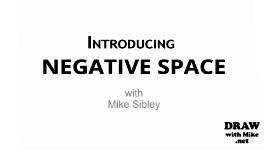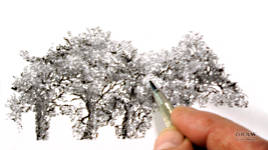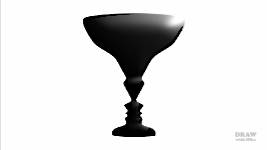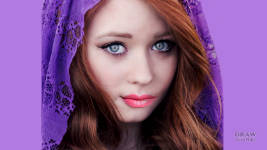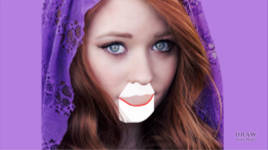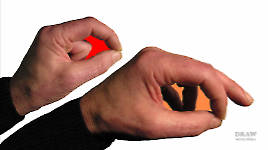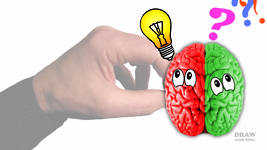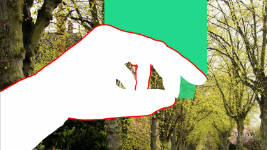Transcript
Negative Space is the artist's best friend - when you know how to see and use it. But HOW do you see it? How can you USE it? And what IS Negative Space?
Well, it can be a number of things...
It could be the area of your drawing that doesn't contain the main focus - the secondary area that, in this case, adds a sense of location. When composing, a natural balance between the weight of the main focus and the weight of the negative space is something you seek to achieve.
It can equally be anything that is not a chosen positive element - the space between the lion and the tree, for example.
It could be internal space. The space, or spaces, outside of the element you are drawing, or struggling to understand. Here, the shapes of these negative spaces have no recognisable form and that's important, as we'll see later.
Or it might be a space that you deliberately draw around - perhaps to later become a light foreground element against the dark background you're currently drawing. However, that's crossing into Negative Drawing territory, which I'll introduce you to in a later video.
Understandably, we graphite artists are used to looking at the dark marks we make with our pencils. The marks tend to grab our attention and demand that we focus on them. After all, they are what constitute "drawing". However, there's a valuable lesson we have to learn. And that is :
You must look at the white too.
The white of our paper is the only white we have available. It shares equal importance with our dark marks. In this case the train IS the negative space created by the trees. And you must be aware of it and preserve its pristine whiteness, until you can make educated decisions that might alter it.
This chalice appears to not be anything special. But its borders are shared. The question is… what did you see first? The chalice? Or two faces in profile?
The faces exist purely because of the shaded area between them. And the chalice owes its existence to the faces. Neither is more important than the other. And, as they share a common boundary, drawing one creates the other.
Understanding this concept is important - as is being able to switch your mind from one to the other - working positively |or negatively. Why is it important? Because negative space is a very powerful tool - especially when you have a potentially difficult or complex subject to draw. It helps you to overcome a major disadvantage that we artists have.
I explained this is an earlier video, but it's equally applicable here, and worth repeating.
We humans possess an inbuilt recognition system. It uses icons for speed. Images stored facing us, never at an angle. Simple, full-face images. It's for safety recognition - if you see a mouthful of large teeth heading in your direction you need to flee. You don't need to know if it's male or female. Or even which animal. Or any anatomical details. All you need to recognise are the teeth! You'll recognise the danger instantly, even if you don't recognise the animal the teeth belong to.
If you drive down a street you know it has trees without having to know the species. Houses, without having to know anything about their design. And cars, without knowing the make or model. They all match the basic icon images you carry.
It's a wonderful system... but not if you're an artist. If you're an artist, it's an interfering nightmare!
Because, when you're drawing, ignoring the whole system is the greatest problem you'll encounter. If you allow it to operate you will draw what you "know" rather than what you see... A three-quarter angled face, for example, that you adorn with a mouth facing the viewer. It's a face... but something doesn't look right. Unsettling, isn't it.
It's also your logical left-brain's desire to name things. "That's a MOUTH! And I KNOW what a mouth looks like." And YOU DO, but only the icon - your stored generic mouth... NOT this girl's mouth.
The best way to defeat this system is to NOT draw the mouth. Instead, study the negative space around that recognisable and nameable feature. Ignore the mouth and draw the adjacent negative space - just the top edge in this case. Now you can truly see the shape of that curve. It's the same edge - but now your attention is on the chin below the mouth, so the mouth has no influence over the result. Repeat that for the negative space above.
Whenever I have a problem correctly visualising any element I look at the negative spaces around it, because those shapes are abstract and cannot be recognised as "being something". That's solved countless problems over the years. DON'T draw what you THINK YOU KNOW, draw what you SEE.
Your hand is a good example. Hold up your left hand, so your thumb and index finger are touching each other. Curl your other fingers into your palm, and hold your hand up against a light background. Study the hole formed by your thumb and finger - THAT is Negative Space.
Try moving your fingers to create different negative spaces. Drawing those shapes will help you draw a believable hand far more accurately than attempting to draw the fingers themselves. The hand is quite complex. The shapes are relatively simple. When you draw a shape you remove the desire to draw a finger. And, as shape and finger share a continuous border, drawing one creates the other.
Surely then we could treat the rearmost fingers, which are almost silhouettes, in the same manner as the spaces between them? Well, no… A silhouette is not the same thing as negative space. Negative space is the area that is NOT a part of the identifiable object. The important word there is "identifiable".
The silhouettes are POSITIVE shapes - shapes the logical left-brain wants to name - to remind you that you already know what a finger look like. But, again, you don't - you only know the generic features and not the intricacies of THAT finger as seen from THAT angle.
The right side of your brain doesn't require reality, or even reason and is quite happy working with abstract shapes. There are times when you study the negative space in a drawing that you can actually feel your left-brain breathing a sigh of relief and letting go. Being unable to identify that unknown shape, it simply gives up.
So... Drawing around a finger will not help you use the power of negative space. The finger is a positive identifiable element, so you will be focusing your attention on the solid shape of the object - and be aware that it's part of a hand. To correctly draw negative space, you observe the shapes formed between the positive parts of the object... or between one edge of the object and a boundary. That boundary could be the edge of a reference photograph, another element within the drawing, or perhaps the side of your pencil if you're drawing from life.
By drawing the negative spaces outside of the object you not only understand the contours of the edges far more clearly, you also leave the object itself untouched - as virgin, white paper.
So, not only will Negative Space assist you in determining the true shapes of elements, it will also preserve the pristine whiteness of your paper. And that's important because, as with watercolour painting, the only white we have as graphite artists is the paper itself.
And that's something we'll explore in the next video.
© copyright: Mike Sibley 2020
